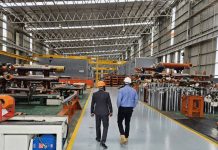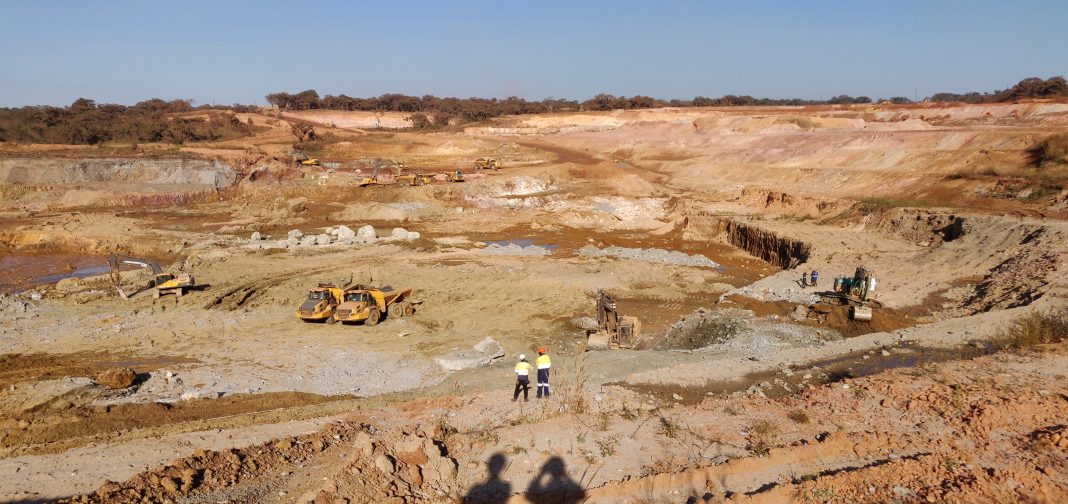With eight months behind us since First Quantum Minerals took to the stage at the 2022 Investing in African Mining Indaba and announced a $100 million cash injection to bring Zambia’s Enterprise Nickel Mine online, the time is ripe for an update.
Mining For Zambia touched base with Enterprise’s team in the country’s North-Western Province to find out how close the project is to producing the first nickel concentrate, on its mission to become a global top-ten producer of the coveted battery metal. Here’s a progress report.
1. Waste stripping: removing waste rock to expose the ore
Waste stripping was “the task of the day” back in July, when the job of digging up millions of tonnes of near-surface level weathered rock (regarded as “waste material”) and moving it out of the way had recently begun. Enterprise has a notably high ‘strip ratio’, meaning that a high proportion of the rock within which nickel ore deposits are found is just that: ordinary rock. In other words, workers will have to remove and relocate around nine cubic metres of waste material for every one cubic metre of ore that can be mined. And it can’t be relocated without due care. Only when waste stripping is done properly can the ore be safely and sustainably exposed.
With more than double the expected amount of rainfall this season, the process has seen its fair share of challenges, say contractors who are working hard to ready the mine for production. But, against the odds, they’re still on track. Approximately 85% of the waste stripping is now complete. And the opportunity to put Enterprise’s pumps and water management systems to the test in fairly extreme conditions was an unexpected silver lining, workers say.
2. The haul road: a surfaced road for transporting ore from the mining pit to the processing plant
A haul road between the mining pit at Enterprise and the nickel processing plant at Sentinel, 15 kilometres away, needs to be surfaced so that ore can be efficiently transported on heavy duty trucks throughout the wet season and dry seasons without stirring up too much dust or mud. Once it reaches Sentinel, the ore will then be crushed, milled and, finally, processed into nickel concentrate in the plant. The road is almost complete – watch this space!
In addition, the team is building a bridge over the haul road so the general public can cross safely, minimising interaction between people in cars or on foot, and mining vehicles.
3. The processing plant: a purpose-built facility for processing nickel ore to make nickel concentrate
This is another big ticket item and, ultimately, the place where the alchemy will happen at Enterprise. The processing plant was constructed within close reach of Sentinel’s copper processing plant back in 2015 but, because of policy instability and a low nickel price, running the plant wasn’t financially viable. The operation was put on ‘care and maintenance’ – or, essentially, decommissioned – with only the bare minimum of work being carried out to prevent damage to equipment and infrastructure.
Years of being out-of-commission have taken their toll. Equipment saw all its rubber parts perish in the summers that have gone by, and everything is in need of thorough servicing – and equally thorough testing – to ensure that it’s in good working order before the plant is officially recommissioned. The good news? The team is on track to complete the process by March 2023.
Project Manager at Enterprise, Axel Kottgen, reports on the progress: “There was a lot of refurbishing to do at the plant, after several years of being basically out-of-action. We have already started to crush some waste material for the purpose of testing the crushers, to make sure the whole system works. At this stage, everything is looking good.”
The next step will be to send the first ore to the crushers and then to the mills for further refinement. That’s on track to happen within the next two months, and the goal is to produce the mine’s first nickel concentrate in the first half of 2023. “We plan to produce between 5,000 and 10,000 tonnes of nickel this year,” says Mr Kottgen. “Then, by the end of 2023, we can declare commercial production.”
“We plan to produce between 5,000 and 10,000 tonnes of nickel this year,” says Mr Kottgen. “Then, by the end of 2023, we can declare commercial production.”
4. More jobs for more locals
When First Quantum Minerals committed to investing a final $100 million to bring Enterprise online, it also committed to creating 700 jobs at the operation. The company is “still actively recruiting” – says Mr Kottgen – but has already filled approximately 600 full time positions.
“Both Enterprise and the mining contractor who is responsible for the mining operation have been striving to recruit labour from the surrounding communities because we want to have locals involved in the project. In terms of unskilled labour, we’ve also been pushing to recruit locally as much as possible,” says Mr Kottgen.
Finding people with the precise skills needed who come from the (rural and still-developing) areas surrounding these mines has been a challenge since Sentinel copper mine was completed in 2015. Enterprise’s team decided it was time to find a way to fill this gap in skills which, in recent years, has often forced mines in North-Western Province to look to Copperbelt Province or other parts of the country when recruiting.
What better way to find people with the right skills locally than to set up a local training centre?
What better way to find people with the right skills locally than to set up a local training centre?
5. A new training centre right on the mine’s doorstep
Enterprise, as part of FQM Trident Ltd, is putting plans in motion to set up an accredited training centre where locals within Kalumbila District can gain the skills that a growing mining sector needs.
“Lately it’s been difficult to find people locally who have the requisite skills because there is a training and education gap in those areas,” says Mr Kottgen. “We want to focus on training the young local communities to fill artisan roles, driving ore trucks and operating mining equipment,” he says. “Training people in the particular skills that are in demand will enable us to recruit more people locally – which ultimately helps to increase employment in the communities around the mine, too.”
The company’s main mining contractor is eager to work with Enterprise to establish the training centre, and will provide equipment and other necessary support.
It’s a win-win situation. Before long, large mining companies like FQM Trident Ltd and mining contractors of all sizes will have a pool of people from which to recruit locally. And, as Enterprise ramps up to become the largest nickel mine on the continent, Zambians with precisely these skills will be increasingly in demand.
***
Keep a look-out for a follow-up piece that shares more information about the plans for the training centre near Enterprise Nickel Mine. You’ll find it on our website or social media platforms, or simply send your address to info@miningforzambia.com to receive an email the minute it’s published.
See also: Full steam ahead

























Can our government look into mining of Zambias minerals as early as possible….
Kcm ,mopani etc